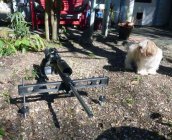I typically use an over-sized LRA "traditional" bipod with a large rear bean bag in F-TR matches, and I heavily pre-load it. I also own a Duplin ski-/sled-type bipod and eared rear bag that I use occasionally during practice. IMO - either type can work equally well. Any differences in overall performance are most likely decided by the individual and their personal preferences. If you like using one style of bipod better than the other you are likely to shoot better with it.
Both types of bipod have caveats to their use. In simplified terms, the key to using a pre-loaded bipod is applying equal pressure during every shot. If uneven pressure is applied to the buttstock, excessive vertical dispersion will be the likely result. In the case of the ski-/sled-type bipod, it is critical that the rifle/bipod track straight rearward during the recoil impulse. If it does not, excessive lateral dispersion will be the likely result. This means that body and rifle alignment is also critical, perhaps even more so than with a pre-loaded "traditional" bipod. Of course, the proper use and caveats involved with getting the most out of each type are a little more complicated than I have outlined here, but you get the idea. Either type can work very well, but the proper postition and usage of each must be practiced/learned.
With respect to the OP's question, I think it would largely hinge on the type of ski feet used. Most F-TR shooters using a ski-type bipod have feet that are thin and somewhat elongated front to back, like a ski or sled runner. Because of this, they tend to track pretty straight front to back if some reasonable surface is used underneath the bipod such as indoor/outdoor carpet, etc. I have a set of Atlas bipod replacement ski feet that are more or less round flat circles with turned-up edges, perhaps about the size of a quarter in diameter. In my hands, these types of "feet" do not tend to track straight back at all and can easily move side-to-side in an undesirable manner during the recoil impulse, certainly not nearly so well as an elongated ski or sled-runner type of foot. In other words, they did not naturally seem to "guide" straight back in my hands. In fairness, once I observed how they behaved, I did not put further effort into learning how to possibly control them, so I can't tell you with certainty it cannot be done. Regardless, it would probably have taken a lot more work for me to do so than with an elongated ski or sled-runner type of foot that already "wants" to track fairly straight.
Along that same line of reasoning, I have heard a few shooters state that they actually allow the rubber feet on their traditional bipods to slide backwards across the benchtop during the recoil impulse when shooting off a bench. I would never even attempt to shoot a traditional bipod that way, but they claim it works well for them, so my opinion really doesn't count for very much. At the end of the day, you have to make whatever bipod setup you choose work the way you want it to. Further, there can be a lot of latitude as to how much you can accomplish with any of the possible setups in that regard, as long as you are willing to devote sufficient practice and attention to how to make a given setup work the way you want it to work. The caveat to that is that some systems may take a lot more work to master than others.











